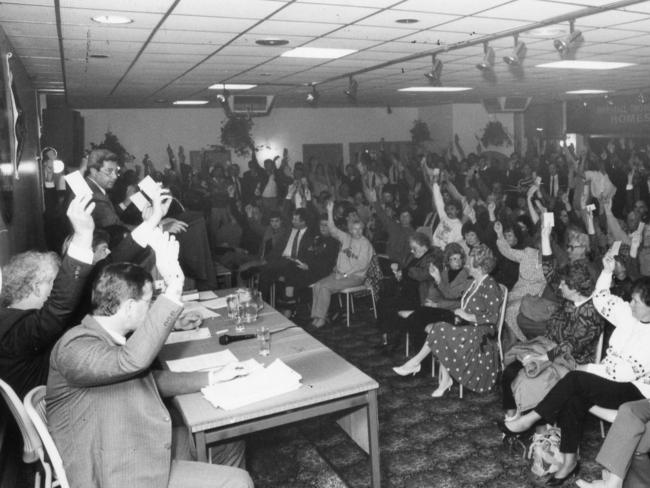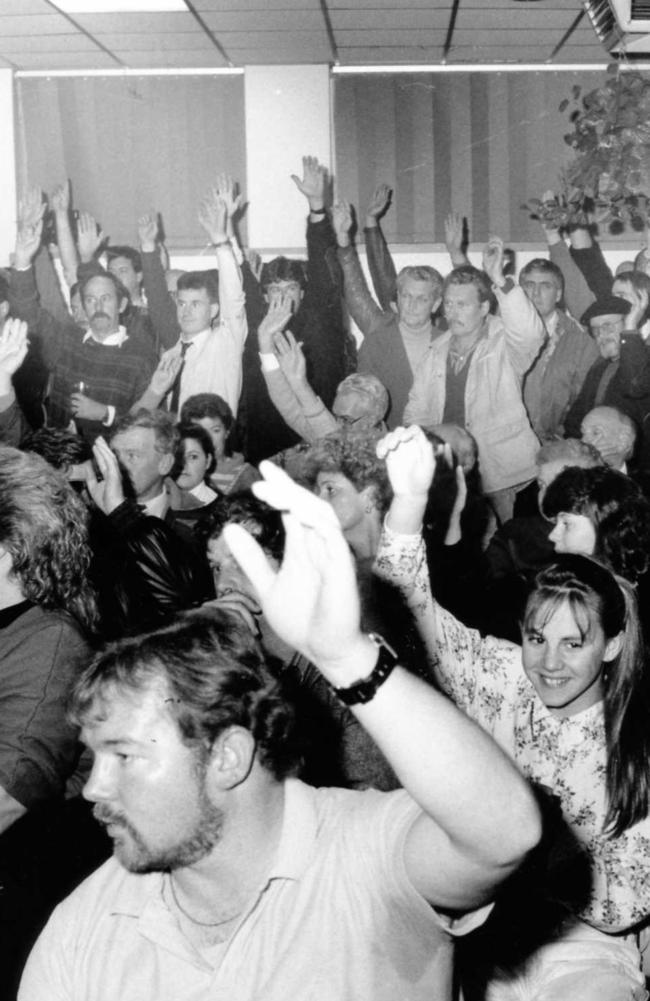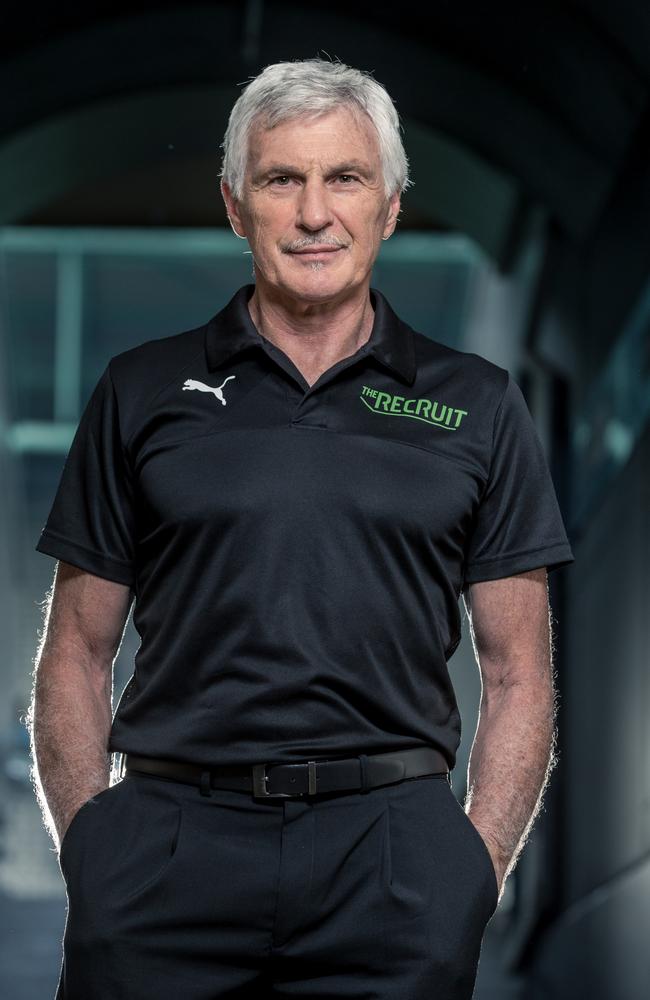Michelangelo Rucci: SANFL grand finalists are stories of triumph against doomsday prophecies
ONE theme remains a dirty word in Australian football (outside country centres): Merger. It is no longer on the AFL agenda, regardless of the obvious note there are too many top-level clubs in Melbourne.
ONE theme remains a dirty word in Australian football (outside country centres): Merger.
It is no longer on the AFL agenda, regardless of the obvious note there are too many (nine) top-level clubs in Melbourne.
Sunday’s SANFL grand final marks another triumph for a visionary — and carries a thought for the SA Football Commission as the money men at the AFL get closer to putting their badge on every State league.
Woodville-West Torrens, the SANFL club presented as the perfect model for mergers in top-level football, will play in its 10th league grand final in 26 seasons since the adventurous amalgamation at the end of 1990. Considering Woodville played in none during its 37 stand-alone league seasons and West Torrens was in a drought after its 1953 triumph, the consistent on-field success of “The Eagles” cannot be questioned.
Nor can how the presence of a strong SANFL club in the western suburbs has nurtured a long line of outstanding AFL draftees — such as Norm Smith Medallist Brian Lake, Fremantle captain Matthew Pavlich and All-Australian Crows defender Brodie Smith.
And the story of how two poorly performing SANFL clubs averted doom is a timely moment for the leaders of SA football.
Bill Sanders was the Woodville Football Club chairman in 1990 as SA football was on the edge of its apocalypse with Port Adelaide’s audacious play to join the nationally expanding VFL.
“Whether it was Port Adelaide or Norwood or the Crows, the landscape — as they say — was going to change forever,” Sanders recalls of his thinking during the turbulent winter that rocked SA football.
“We were squeezed between North Adelaide, Port Adelaide, West Torrens and West Adelaide ... our opportunity to grow was going to be very limited. So unless Woodville made some tough decisions, ultimately we would have no say in our destiny and our future.
“We could have been easily picked off by Port Adelaide.”

The path to the merger was, predictably, far from simple — or quickly accepted.
“I raised it a couple of times at Woodville board meetings ... there was not a lot of support,” recalls Sanders.
So the agenda was changed to start with a question: “What is the future of the Woodville Football Club?” The same theme could apply with the SANFL today as the task of finding a vision — a mission statement — for the next decade looms large on Australia’s oldest football competition.
A “think-tank” session at the Challa Gardens Hotel left Woodville with two firm conclusions: First, a partnership with an SANFL neighbour was the best option to secure the club’s future, particularly when the AFL was coming to town. Woodville looked at West Adelaide, Port Adelaide, “briefly” North Adelaide and ultimately settled on West Torrens because “there were a lot of similarities” between the clubs.
Second, it is always best to negotiate with strong cards in hand. Woodville kept its home base because it had a better relationship with its council on the management of its home ground than West Torrens had at Thebarton Oval. Woodville was financially sound; West Torrens was not — and the merger was only sanctioned once the SANFL agreed to wipe out the Eagles’ outstanding wind-up debt of $140,000.
As the SANFL watches WA football get closer to being badged as AFL Western Australia (rather than WAFL), State league chief executive Jake Parkinson may ask: Is it better to negotiate a partnership with the AFL today ... rather than be forced to compromise heavily to AFL House later?
The SANFL clings to its independence, its right to control its patch — as highlighted by this year’s decision to change rules in the State league. It may be easier to secure this today in a partnership with the AFL than a “takeover” later.

In 1990, Sanders and at-the-time West Torrens president Rex Sellers advanced from secret meetings at Sanders’ home at Woodville South and with SANFL leaders, president Max Basheer and chief executive Leigh Whicker, at an Angas Street restaurant to create “The Eagles”.
“If we hadn’t,” says Sanders, “it is doubtful either club would have survived. Both would have gone to the wall.
“We know some people resented the merger. Some found it difficult to give up their club’s heritage for a new club. But gradually people have come around — they have a reason to go to the footy now.”
Woodville-West Torrens tomorrow plays Sturt, a club that has often been thrown against the wall in the new AFL era in SA football. The merger with Norwood never came to be after their combined bid for the second SA-based AFL licence was rejected in 1994. Club legend John Halbert’s wish for the Double Blues to allow themselves to become the Crows reserves unit never gained significant support.
And Sturt keeps up the battle, learning the benefit of staying strong connected with its fans.
“People, that’s the key,” says Sanders. “They make a football club — people.”
REALITY BITES
THEY WILL GO
ALL is well again. For the third consecutive SANFL season — noted for AFL reserves teams from the Crows and Power in the State league — the league premiership will be won by a “traditional” club, either Woodville-West Torrens or Sturt.
For the second consecutive season, the SANFL grand final will have no AFL content.
But the debate on AFL reserves teams in the SANFL will no go away, either in official channels (where the SANFL league directors admit they should have demanded more of the Crows) or among the so-called State league “diehards”.
The Adelaide Football Club did originally say it wanted a “unanimous” vote of support for its entry to the SANFL — and then accepted a majority 6-2 vote. And now the Crows say they will get out of the SANFL if they are not wanted and take up options in the VFL or the NEAFL.
Adelaide has costed these options finding it would cost between $500,000 and $550,000 to play in either the Victorian competition or the NSW-ACT-Queensland combine — just $100,000 more than its annual licence fee in the SANFL.
But the SANFL clubs will not vote the Crows out of their competition. The league directors are well aware of the damage done to the State league if the Crows play elsewhere and have reserves games in Adelaide in opposition to the SANFL.
Still, the debate will go on ...
FINAL COUNT
IT should be one game — “Australia’s Game” — with one set of rules.
But the SANFL always has been independent, creative, innovative — and different (be it with team line-ups starting from attack, percentage and 25-metre penalties rather than 50).
There were many raised eyebrows when the SANFL became radical with rule changes this season, in particular the “last touch” rule at the field boundaries. The result:
SCORING has increased 10 per cent (from a game average of 133.8 to 146.9 — just shy of the AFL average of 147 points). Elsewhere — in the VFL, WAFL and NEAFL — scoring has fallen this season.
STOPPAGES have decreased by 24 per cent (from a game average of 76.3 to 58.1) while other State leagues have developed more congested play.
The SANFL will say it has been vindicated. The figures will make the case.
DOUBLE TAKE
AFL recordkeeper Col Hutchison has fallen off his chair. The Gowans twins — Chris and James, who are very difficult to tell apart — have revealed the greatest “Fine Cotton” switch in AFL history.
Chris Gowans told the Carbine Club SANFL grand final luncheon at Adelaide Oval that he replaced his twin brother James in his fourth and last AFL game with St Kilda in 1999.
James Gowan played for the Saints in Rounds 15, 16 and 17 — against Fremantle, Brisbane and Melbourne — and left the Round 18 clash with Adelaide at Waverley Park to Chris.
“He (James) played the three s ... ones and I played the one good one,” Chris said.
Hutchison may argue. James Gowan had 18, 10 and 16 disposals in the first three games. Whoever it was who played against the Crows in the fourth match had just two touches.
TAKE NOTE
“WAKE up to yourselves.”
Magarey Medallist GARRY McINTOSH to AFL players — who are on an annual average salary of $300,000 — seeking a pay rise in the new collective bargaining agreement while there is significant financial pain at lower levels of Australian football. The more the AFL players collect, the less that filters to the State leagues and amateur, country and community football.
GOTCHA
TRIPLE M’s Dale Lewis was the first to tumble ... and many followed this week.
On social media, the masked man calling himself “AFL Trade Whisperer” created an avalanche of interest in his Twitter account as he declared — and demanded retweets — that the Adelaide Football Club would trade for Richmond club champion Dustin Martin.
The AFL now has a repeat of English Premier League football in 2012 when teenager Sam Gardiner from north London created a fake Twitter account, loaded up false transfer rumours and not only collected thousands of followers but had his fabricated quotes and deception given “credibility” by being repeated in the mainstream media.
The “Martin to Crows” Tweet was fishy as soon as the detail developed an annual salary of $1 million — a figure the Adelaide Football Club does not pay while it follows the Hawthorn and Geelong theme of not having its salary cap heavily pinned on one player.
POWER PLAY
MARK Williams created quite an academy of football coaches with his 2004 AFL premiership team at Port Adelaide. Already, two — Chad Cornes and Brendon Lade — are back at Alberton in significant roles while Stuart Dew and Josh Francou have done wonders with the Sydney midfield.
Outside the AFL system there is one of the 2004 Power premiership heroes who is putting together quite a resume as a senior coach. Jarrad Schofield has won the past two WAFL premierships for Subiaco and is seeking to complete the hat-trick this weekend by leading the Lions against the Fremantle-backed Peel Thunder.
QUOTE OF THE WEEK
“I’ll categorically tell you this is an absolute fact. There are some absolute shonks, some real skunks that are managers ... they are just the worst people to deal with.”
AFL premiership great MICHAEL MALTHOUSE giving his view on the “Jerry Maguire” clan in AFL player management field.

michelangelo.rucci@news.com.au
